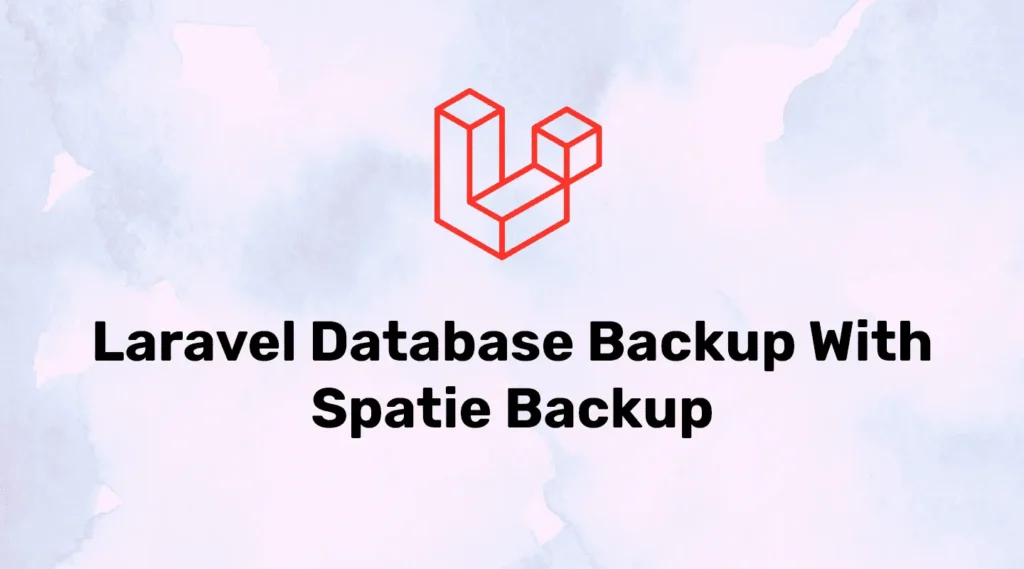As we already know database backup is an essential part of the software development process. But sometimes it will become messy or time-consuming to manually take database backups check which database is older and delete older databases. You will feel great after knowing that the Spatie Laravel-Backup library can perform most of the database backup operations easily. like creating database backups, handling events (success or failure), or deleting old database backups that take up unnecessary space.
Database backups are essential for protection against data loss that can disrupt operations and could lead to major problems, especially with E-commerce, ERP, HRMS, or any other system in which data is the backbone.
In this example, we will take database backup using the Spatie Laravel backup library. We will follow below steps for a better understanding:
- Create Laravel Project
- Configure Database
- Install & Configure Laravel Spatie Package
- Setting up backup
- Take Backup
Create Laravel Application
Let’s begin with creating a new Laravel application or using an existing one. Open your terminal end and enter the appropriate command:
composer create-project --prefer-dist laravel/laravel DbBackup
//If you already installed laravel globel installer
laravel new DbBackupIt will take some time to create a project.
Database Configuration
Our application is created. Let’s configure a database for our application. If you don’t have a database then create a new one. After making the database open the .env file from the root directory of your project. if the .env file is missing from the project then copy content from the .env.example and create file. .env file defines many common environment variables
DB_CONNECTION=mysql
DB_HOST=127.0.0.1
DB_PORT=3306
DB_DATABASE=**********
DB_USERNAME=*********
DB_PASSWORD=*********Install and Configure Laravel Spatie Package
To install the package we will use Composer. Open your terminal and enter below command :
composer require spatie/laravel-backupThis command will download and extract the package using Composer and install it into our application. While using Spatie database backup, we need to consider that Spatie will take backup and send it through email. So, we need to configure mail configuration in our application.
Add the mail address in the .env file.
MAIL_FROM_ADDRESS=test@gmail.com
MAIL_FROM_NAME="${APP_NAME}"Next step we will register the service provided to our application. Get inside config/app.php search for the package service provided and modify it.
'providers' => [
...
...
...
Spatie\Backup\BackupServiceProvider::class,
];We also need to publish some package files. Open the terminal and enter the below command:
php artisan vendor:publish --provider="Spatie\Backup\BackupServiceProvider"Setting up backup
After installation, you can set Spatie database configurations as per your requirements. In general use, a pre-defined configuration is great but sometimes you need to change some values. You can achieve it by modifying the config/backup.php file.
<?php
return [
'backup' => [
/*
* The name of this application. You can use this name to monitor
* the backups.
*/
'name' => env('APP_NAME', 'laravel-backup'),
'source' => [
'files' => [
/*
* The list of directories and files that will be included in the backup.
*/
'include' => [
base_path(),
],
/*
* These directories and files will be excluded from the backup.
*
* Directories used by the backup process will automatically be excluded.
*/
'exclude' => [
base_path('vendor'),
base_path('node_modules'),
],
/*
* Determines if symlinks should be followed.
*/
'follow_links' => false,
/*
* Determines if it should avoid unreadable folders.
*/
'ignore_unreadable_directories' => false,
/*
* This path is used to make directories in resulting zip-file relative
* Set to `null` to include complete absolute path
* Example: base_path()
*/
'relative_path' => null,
],
/*
* The names of the connections to the databases that should be backed up
* MySQL, PostgreSQL, SQLite and Mongo databases are supported.
*
* The content of the database dump may be customized for each connection
* by adding a 'dump' key to the connection settings in config/database.php.
* E.g.
* 'mysql' => [
* ...
* 'dump' => [
* 'excludeTables' => [
* 'table_to_exclude_from_backup',
* 'another_table_to_exclude'
* ]
* ],
* ],
*
* If you are using only InnoDB tables on a MySQL server, you can
* also supply the useSingleTransaction option to avoid table locking.
*
* E.g.
* 'mysql' => [
* ...
* 'dump' => [
* 'useSingleTransaction' => true,
* ],
* ],
*
* For a complete list of available customization options, see https://github.com/spatie/db-dumper
*/
'databases' => [
'mysql',
],
],
/*
* The database dump can be compressed to decrease diskspace usage.
*
* Out of the box Laravel-backup supplies
* Spatie\DbDumper\Compressors\GzipCompressor::class.
*
* You can also create custom compressor. More info on that here:
* https://github.com/spatie/db-dumper#using-compression
*
* If you do not want any compressor at all, set it to null.
*/
'database_dump_compressor' => null,
/*
* The file extension used for the database dump files.
*
* If not specified, the file extension will be .archive for MongoDB and .sql for all other databases
* The file extension should be specified without a leading .
*/
'database_dump_file_extension' => '',
'destination' => [
/*
* The filename prefix used for the backup zip file.
*/
'filename_prefix' => '',
/*
* The disk names on which the backups will be stored.
*/
'disks' => [
'local',
],
],
/*
* The directory where the temporary files will be stored.
*/
'temporary_directory' => storage_path('app/backup-temp'),
/*
* The password to be used for archive encryption.
* Set to `null` to disable encryption.
*/
'password' => env('BACKUP_ARCHIVE_PASSWORD'),
/*
* The encryption algorithm to be used for archive encryption.
* You can set it to `null` or `false` to disable encryption.
*
* When set to 'default', we'll use ZipArchive::EM_AES_256 if it is
* available on your system.
*/
'encryption' => 'default',
],
/*
* You can get notified when specific events occur. Out of the box you can use 'mail' and 'slack'.
* For Slack you need to install laravel/slack-notification-channel.
*
* You can also use your own notification classes, just make sure the class is named after one of
* the `Spatie\Backup\Events` classes.
*/
'notifications' => [
'notifications' => [
\Spatie\Backup\Notifications\Notifications\BackupHasFailed::class => ['mail'],
\Spatie\Backup\Notifications\Notifications\UnhealthyBackupWasFound::class => ['mail'],
\Spatie\Backup\Notifications\Notifications\CleanupHasFailed::class => ['mail'],
\Spatie\Backup\Notifications\Notifications\BackupWasSuccessful::class => ['mail'],
\Spatie\Backup\Notifications\Notifications\HealthyBackupWasFound::class => ['mail'],
\Spatie\Backup\Notifications\Notifications\CleanupWasSuccessful::class => ['mail'],
],
/*
* Here you can specify the notifiable to which the notifications should be sent. The default
* notifiable will use the variables specified in this config file.
*/
'notifiable' => \Spatie\Backup\Notifications\Notifiable::class,
'mail' => [
'to' => 'your@example.com',
'from' => [
'address' => env('MAIL_FROM_ADDRESS', 'hello@example.com'),
'name' => env('MAIL_FROM_NAME', 'Example'),
],
],
'slack' => [
'webhook_url' => '',
/*
* If this is set to null the default channel of the webhook will be used.
*/
'channel' => null,
'username' => null,
'icon' => null,
],
],
/*
* Here you can specify which backups should be monitored.
* If a backup does not meet the specified requirements the
* UnHealthyBackupWasFound event will be fired.
*/
'monitor_backups' => [
[
'name' => env('APP_NAME', 'laravel-backup'),
'disks' => ['local'],
'health_checks' => [
\Spatie\Backup\Tasks\Monitor\HealthChecks\MaximumAgeInDays::class => 1,
\Spatie\Backup\Tasks\Monitor\HealthChecks\MaximumStorageInMegabytes::class => 5000,
],
],
/*
[
'name' => 'name of the second app',
'disks' => ['local', 's3'],
'health_checks' => [
\Spatie\Backup\Tasks\Monitor\HealthChecks\MaximumAgeInDays::class => 1,
\Spatie\Backup\Tasks\Monitor\HealthChecks\MaximumStorageInMegabytes::class => 5000,
],
],
*/
],
'cleanup' => [
/*
* The strategy that will be used to cleanup old backups. The default strategy
* will keep all backups for a certain amount of days. After that period only
* a daily backup will be kept. After that period only weekly backups will
* be kept and so on.
*
* No matter how you configure it the default strategy will never
* delete the newest backup.
*/
'strategy' => \Spatie\Backup\Tasks\Cleanup\Strategies\DefaultStrategy::class,
'default_strategy' => [
/*
* The number of days for which backups must be kept.
*/
'keep_all_backups_for_days' => 7,
/*
* The number of days for which daily backups must be kept.
*/
'keep_daily_backups_for_days' => 16,
/*
* The number of weeks for which one weekly backup must be kept.
*/
'keep_weekly_backups_for_weeks' => 8,
/*
* The number of months for which one monthly backup must be kept.
*/
'keep_monthly_backups_for_months' => 4,
/*
* The number of years for which one yearly backup must be kept.
*/
'keep_yearly_backups_for_years' => 2,
/*
* After cleaning up the backups remove the oldest backup until
* this amount of megabytes has been reached.
*/
'delete_oldest_backups_when_using_more_megabytes_than' => 5000,
],
],
];Take backup
Our setup is ready to take backup. We will take all the files and database using the below command.
php artisan backup:runIt will take database backup.
Conclusion
The backup of the Laravel application is necessary. Here, we have created a Laravel app and database backup using Spatie backup from beginning to end.



